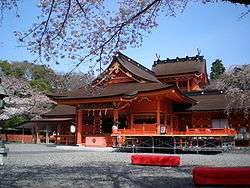Fujisan Hongū Sengen Taisha
| Fujisan Hongū Sengen Taisha 富士山本宮浅間大社 | |
|---|---|
|
Honden of Fujisan Hongū Sengen Taisha | |
| Information | |
| Type | Asama Shrine |
| Dedicated to | Konohanasakuya-hime |
| Address | 1-1 Miya-chō, Fujinomiya, Shizuoka, 418-0067 |
| Website |
www |
|
| |
The Fujisan Hongū Sengen Taisha (富士山本宮浅間大社) is a Shintō shrine in the city of Fujinomiya in Shizuoka Prefecture, Japan. It is the ichinomiya of former Suruga Province, and is the head shrine of the 1300 Asama or Sengen shrines in the country. The shrine has an extensive location within downtown Fujinomiya; in addition, the entire top of Mount Fuji from the 8th stage upwards is considered to be part of the shrine grounds.
The main festival of the shrine is held annually on May 5, and features yabusame performances.[1]
In 2013, the shrine was added to the World Heritage List as part of the Fujisan Cultural Site.[2]
Enshrined kami
The primary kami of Fujisan Hongū Sengen Taisha is Konohanasakuya-hime (木花咲耶姫), the daughter of Ōyamatsu-no-mikoto (大山祇命). Mount Fuji was deified and its kami was named Asama no Okami (浅間大神), also known as Asama Daimyōjin (浅間大明神), Asama Gongen (浅間権現) or Sengen Daibōsatsu (浅間大菩薩), and is associated with Konohanasakuya-hime.
History
The foundation of the Fujisan Hongū Sengen Taisha predates the historical period. Per shrine tradition, it was established in reign of Emperor Suinin, with the shrine first built on its current location during the reign of Emperor Keikō. This was a period of intense volcanic activity on Mount Fuji, and the shrine was built in order to appease the kami of the mountain. The shrine is mentioned in accounts of the legendary hero Yamato Takeru as well. The entire mountain was off-limits for religious reasons, except for Shugendō monks noted for the asceticism.
Historical records, however, only exist as far as the early ninth century. During the reign of Emperor Heizei, Sakanoue no Tamuramaro was ordered to rebuild the Honden of the shrine in its current location. The Heian period Engishiki records list the shrine as the ichinomiya of Suruga Province. Pilgrimages to Mount Fuji became common in the ninth century, although women were forbidden from climbing.
During the Kamakura period, Shōgun Minamoto Yoritomo was a frequent visitor to the shrine during his hunting expeditions/war games at the base of Mount Fuji, beginning the tradition of yabusame during the shrine’s festivals and association with the samurai class. Through the Muromachi period, the Ashikaga clan, Odawara Hōjō, the Imagawa clan, the Takeda clan and the Tokugawa clan were patrons of the shrine. Tokugawa Ieyasu made a large donation after his victory at the Battle of Sekigahara, and subsequent generations of the Tokugawa shogunate kept the shrine in good repair. During the Edo period, the shrine was the center of a cult worshipping Mount Fuji, and drew pilgrims from all over Japan. The Sengen Taisha was the place at which pilgrims would purify themselves in water before beginning the ascent.
From 1871 through 1946, the Fuji Hongū Sengen Taisha was officially designated one of the Kanpei-taisha (官幣大社), meaning that it stood in the first rank of government supported shrines.[3] Today, some 400,000 pilgrims climb Mount Fuji every year, and many of them stop at the shrine in order to wish for a safe climb.

Notable structures
The Honden of the shrine is in the distinctive sengen-zukuri style with a two-story gate tower. It was built in 1604 per a donation by Tokugawa Ieyasu, but has been repaired several times, most notably after the Ansei Tōkai earthquake of 1854. It is registered as a National Important Cultural Property.
The large pond Wakutama-ike (湧玉池) in the shrine grounds contains a spring which is the headwaters of the Kanda river, a minor tributary of the Fuji River. It is protected as a National Natural Monument.
See also
References
- Clark, Timothy (2001). 100 Views of Mount Fuji. Weatherhill Books. ISBN 0-8348-0492-1.
- Plutschow, Herbe. Matsuri: The Festivals of Japan. RoutledgeCurzon (1996) ISBN 1-873410-63-8
- Ponsonby-Fane, Richard Arthur Brabazon. (1962). Studies in Shinto and Shrines. Kyoto: Ponsonby Memorial Society. OCLC 3994492
- ____________. (1959). The Imperial House of Japan. Kyoto: Ponsonby Memorial Society. OCLC 194887
External links
- Official site of the shrine
- "Japan-Guide.com". Retrieved 2006-10-09.
- "Shizuoka". Japan National Tourist Organization. Retrieved 2006-10-09.
- Yasunari, Wada (2005-12-15). "Mount Fuji: A Trek to the Top". Nipponia. Web Japan. Retrieved 2006-10-10.
Notes
- ↑ Plutschow. Matsuri: The Festivals of Japan. Page 173
- ↑ "Fujisan, sacred place and source of artistic inspiration: Maps". World Heritage. UNESCO. Retrieved 2013-07-04.
- ↑ Bernstein, Andrew. "Whose Fuji?: Religion, Region, and State in the Fight for a National Symbol," Monumenta Nipponica, Vol. 63, No. 1, Spring 2008, pp. 51-99; Ponsonby-Fane, Richard. (1959). The Imperial House of Japan, pp. 125.
Coordinates: 35°13′39″N 138°36′37″E / 35.22750°N 138.61028°E
